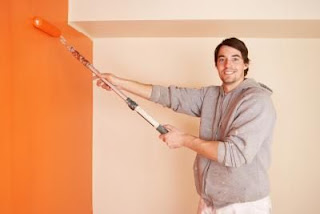Roller Selection
The type of roller material depends on the paint type. Natural materials, such as lambswool, work better with oil-based paint because they deliver the paint smoothly to the wall with minimal splattering. Synthetic rollers, such as nylon or polyester, work better for water-based and latex paints. The right roller nap can further minimize splatters. Thinner naps absorb less excess paint and reduce splatters on smooth walls and surfaces. Thicker naps work best on rough surfaces that require more paint for an even coat. Avoid rollers with seams, and purchase those with beveled edges to further reduce splatters and ensure even coverage.
Paint Trays
The correct paint tray is nearly the same width as the roller so that excess paint doesn't collect on the ends of the roller. Too much paint on the roller ends can result in splatters as you roll it across the wall. A good paint tray has a slope or ramp to roll the roller up and squeeze out the excess paint. The ramp must have raised ridges to help force out excess paint. Avoid overfilling the paint tray. Filling only the reservoir at the base of the ramp and refilling it as necessary further prevents the roller from absorbing too much paint.
Roller Screens
Roller screens work better than trays for reducing splatters, and there's no need to refill a tray repeatedly. These screens stand upright in a 5-gallon bucket. Simply pour a gallon of paint in the bottom of the bucket and dip the roller into it. Roll the roller up the screen to push out all the excess paint so it won't splatter when you apply it to the wall. Using a bucket with a lid allows you to cover leftover paint so it doesn't dry out.
Paint Application
Although the wrong roller or too much paint on the roller results in most splatters, improper paint application can also result is a splatter. Rollers aren't meant for cutting into corners or painting along edges. Forcing them into these tight spots can result in splatters, so use a brush instead. Begin painting a large wall by first making an “M” shape with the roller and then filling it in using long, smooth roller strokes. Refill the roller with paint as necessary so the paint goes on smoothly without the need for pressure. Pressing down on the roller to force the paint out can result in a splatter.
